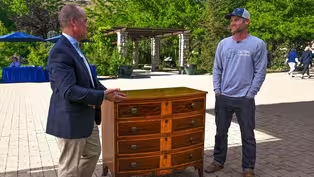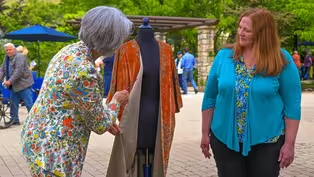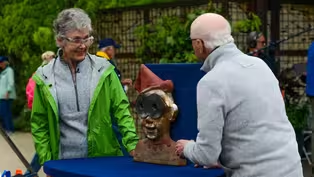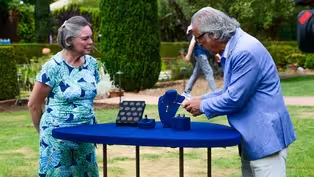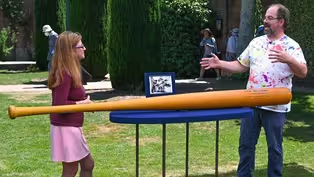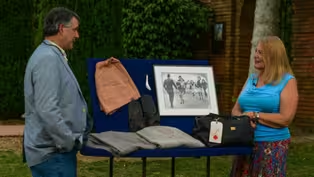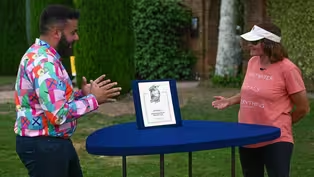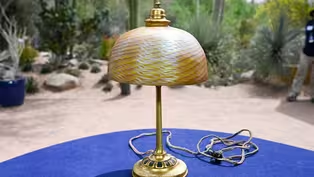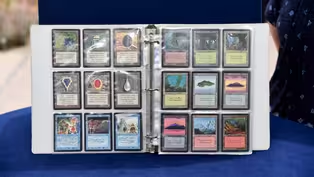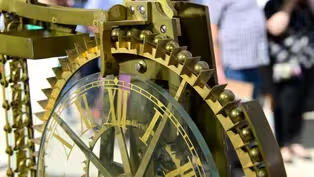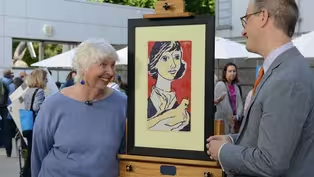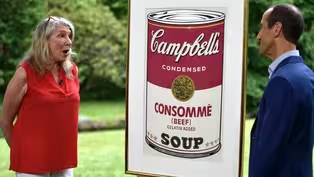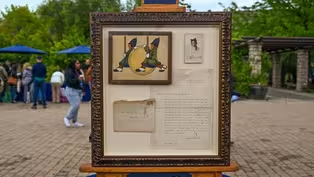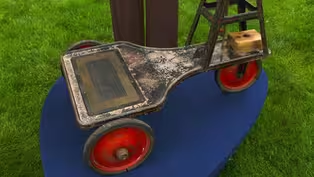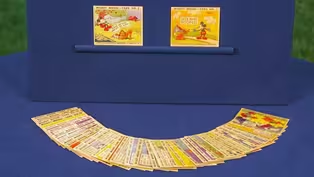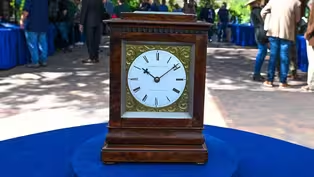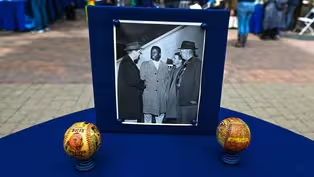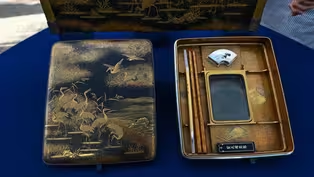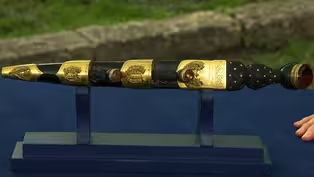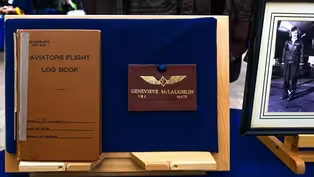
RECUT: Idaho Botanical Garden, Part 4
Special | 22m 31sVideo has Closed Captions
Wrap up Season 4 of RECUT with a $50,000 appraisal at Idaho Botanical Garden!
Wrap up Season 4 of RECUT with appraisal that include George Sosnak baseballs & Hank Aaron-signed photo, 1935 Gum Inc. Mickey Mouse cards, and 1906 Maxfield Parrish oil with letter. One is $50,000!
Problems playing video? | Closed Captioning Feedback
Problems playing video? | Closed Captioning Feedback
Funding for ANTIQUES ROADSHOW is provided by Ancestry and American Cruise Lines. Additional funding is provided by public television viewers.

RECUT: Idaho Botanical Garden, Part 4
Special | 22m 31sVideo has Closed Captions
Wrap up Season 4 of RECUT with appraisal that include George Sosnak baseballs & Hank Aaron-signed photo, 1935 Gum Inc. Mickey Mouse cards, and 1906 Maxfield Parrish oil with letter. One is $50,000!
Problems playing video? | Closed Captioning Feedback
How to Watch Antiques Roadshow
Antiques Roadshow is available to stream on pbs.org and the free PBS App, available on iPhone, Apple TV, Android TV, Android smartphones, Amazon Fire TV, Amazon Fire Tablet, Roku, Samsung Smart TV, and Vizio.
Buy Now
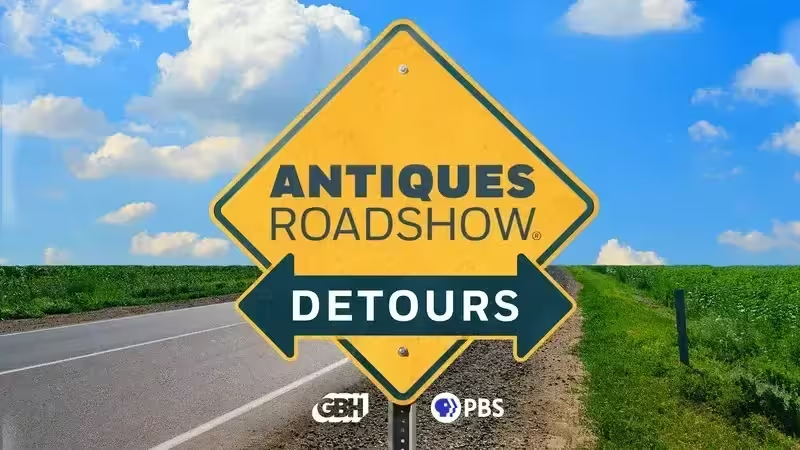
ANTIQUES ROADSHOW DETOURS
Ever wondered what happens to the treasures featured on America’s beloved ANTIQUES ROADSHOW after the cameras leave town? Host Adam Monahan tracks down the juicy afterlives of your favorite finds from PBS’s hit series.Providing Support for PBS.org
Learn Moreabout PBS online sponsorshipMore from This Collection
America’s favorite treasure hunt ANTIQUES ROADSHOW presents a bite-sized way to enjoy the show. ANTIQUES ROADSHOW RECUT features thirty-minute episodes, packed full of favorite finds and paced for maximum entertainment. RECUT features episodes recut from the show’s previous visits to distinctive and historic locations across the country.
RECUT: Idaho Botanical Garden, Part 3
Video has Closed Captions
Visit the “City of Trees” for unbe-leaf-able Boise treasures in this half-hour RECUT. (22m 31s)
RECUT: Idaho Botanical Garden, Part 2
Video has Closed Captions
In this half-hour RECUT, watch breathtaking Boise appraisals at Idaho Botanical Garden. (22m 31s)
RECUT: Idaho Botanical Garden, Part 1
Video has Closed Captions
Gem State treasures sparkle in this half-hour RECUT at Idaho Botanical Garden! (22m 31s)
Video has Closed Captions
Watch wow-worthy Woodside finds in this half-hour RECUT and learn which is up to $44,000! (22m 24s)
Video has Closed Captions
In this half-hour RECUT episode, golden state treasures shine at Filoli. One is $150,000! (22m 23s)
Video has Closed Captions
Watch fascinating Filoli finds in this half-hour RECUT, including one up to $100,000! (22m 36s)
Video has Closed Captions
This season's first half-hour of RECUT wows our guests with a $200,000 to $330,000 find! (22m 30s)
RECUT: Desert Botanical Garden, Part 2
Video has Closed Captions
Phoenix treasures heat up, like one appraisal up to $35,000, in this half-hour RECUT! (22m 28s)
RECUT: Desert Botanical Garden, Part 1
Video has Closed Captions
Phenomenal Phoenix finds abound in this half-hour RECUT. One is worth up to $100,000! (22m 26s)
RECUT: Crocker Art Museum, Part 2
Video has Closed Captions
See stunning Sacramento finds like one $80,000-$125,000 treasure, in this half-hour RECUT! (22m 28s)
RECUT: Crocker Art Museum, Part 1
Video has Closed Captions
Head to California’s Crocker Art Museum for a bite-sized RECUT! One find is up to $75,000! (22m 27s)
RECUT: Winterthur Museum, Garden & Library, Part 2
Video has Closed Captions
Discover Delaware treasures in this half-hour RECUT, including one valued at $50,000! (22m 27s)
Providing Support for PBS.org
Learn Moreabout PBS online sponsorship♪ ♪ CORAL PEÑA: "Antiques Roadshow Recut" is uncovering more surprises at the Idaho Botanical Garden.
You literally discovered these, like, the night before coming...
Yes.
...to "Antiques Roadshow"?
Right before we came.
Wow.
(gasps) (laughing): Blows my mind.
♪ ♪ PEÑA: In this half hour, "Antiques Roadshow Recut" continues our visit to the Idaho Botanical Garden in Boise.
The grounds of what used to be the Old Idaho Penitentiary are buzzing with guests eager to learn more about their items.
Let's roll right into it.
This is a pump cart that was manufactured by Buddy L Toys in Moline, Illinois.
And my father-in-law's uncle was a toy designer there.
And this is a prototype.
It was never put into production, we're guessing because it's pretty dangerous.
(chuckles): Okay.
It's very tippy, and when the handle gets moving at any speed, it's difficult to control.
It's just the right length where you could smack a child under the chin.
APPRAISER: Right.
Frederick A. Lundahl, his company started in 1910.
He actually made auto parts.
He worked with the farm machine companies.
In about the 1920s, there was a downturn in needing the parts.
And so he had a five-year-old son and decided to take some of that scrap metal and make a good, sturdy toy that was educational, in that it had working parts that the kids could learn from, they could have fun, and it wouldn't fall apart.
His son's name was Arthur, but he went by Buddy.
GUEST: Oh, okay.
APPRAISER: And the L, of course, for Lundahl.
This toy is made out of the heavy pressed steel...
GUEST: Mm-hmm.
APPRAISER: ...which Buddy L was known for.
On the bottom, we have a patent number.
It was given to Frederick Lundahl for a velocipede.
Oh!
And a velocipede is just a human-powered land vehicle.
When you pull up the patent information, the illustrations show that, while this probably is a prototype, this is not the first.
This is a slightly different product.
Oh!
They had a rectangular base instead of a shaped base.
It was four wheels rather than three wheels.
All right.
And it had two handles.
Oh.
So if you think this is dangerous for one child, can you imagine... (laughs) ...one child on each end, with one going backwards down a hill?
No, I can't imagine.
APPRAISER: So there were some changes that were made.
This piece actually did go into production.
GUEST: Oh, it did?
APPRAISER: This piece would have been made in 1929.
Your family probably were the test for this particular piece... (laughs) Could be.
...as they went flying down the hills and tipping over.
Yeah!
The actual pieces that went into production and were sold were over a foot wider at the base... Mmm, mmm.
APPRAISER: ...and the handle was four inches shorter.
I would put an auction value on this piece of somewhere between $6,000 and $8,000.
(gasps, laughs) So... Whoa!
So... (both laughing) So hopefully nobody got their teeth too badly cracked with this one.
(laughs) I have to say, I am really amazed.
What were you expecting?
I thought maybe $500 or $600.
Yeah, yeah.
GUEST: Well, we brought a couple of baseballs and a picture from my grandfather's collection.
I'm not really sure when he got these.
Unfortunately, before he passed away, he did not tell us a lot about them.
We kind of found them once he was gone.
He passed away about 21 years ago.
Okay.
So we've had 'em since then.
So tell us more about your grandfather.
Who was he?
Well, his name was Bill Campbell.
He was Mr.
Baseball in Boise.
So he worked to help bring the Braves organization to Boise.
Over time, the Braves kind of left, and, and, and things didn't go well.
And then in 1989, he brought the Boise Hawks organization.
And of course, when they first started, they were, I believe it's a California Angels-affiliated team.
So they were a, a Single-A team.
And so we had professional baseball in Boise ever since.
These balls were from his collection.
They seem to be painted.
One of them is personalized to my grandfather.
It says "To Bill Campbell" on it.
This is my grandfather, Bill Campbell.
And, of course, he is meeting a famous baseball player there.
He signed the picture to him, and we don't really know what year that was.
We think it was in the late '50s when he came to town.
So the two baseballs are by n, noted artist George Sosnak.
Besides LeRoy Neiman, George Sosnak is the one that you want.
Okay.
He's the baseball artist that everybody loves.
He was an umpire, he was a player.
He loved the game, loved the players, and he was meticulous.
On this ball, which is Roger Maris, we not only had his signature... Mm-hmm.
...we have images of him playing.
We have stats from 1961.
You know what's important about 1961?
Some big home run thing, yes.
He hit 61 home runs in 1961...
Yes, yeah.
...to break Babe Ruth's record.
But my favorite part about this is, you have an inscription.
Mm-hmm.
And it says that it's from Roger Maris to your grandfather.
You have one of the best athletes, Roger Maris, you have one of the best events in baseball, which is hitting 61 home runs in a single season... Mm-hmm.
...and it's dedicated to your grandfather.
So let's talk about the 1958 Boise Braves.
Now, the Boise Braves was a Pioneer League team.
So that was an affiliate of the MLB.
And they were associated with the Milwaukee Braves at the time.
Mm-hmm.
And so, and the Boise Braves were running about 1955 to 1963.
Mm-hmm, hm.
And again, inscribed to your grandfather.
Now, the Boise Braves image, let's talk about that, 'cause that was normal back then, but today we see it through different eyes.
It's a negative caricature.
Certainly.
And that's not how we want to represent American Indians.
And we're seeing teams change their names.
Now, the Boise Braves were an affiliate of the Milwaukee Braves, which now became the Atlanta Braves.
Mm-hmm.
And they haven't changed their name yet.
But we have seen the Cleveland Indians change to the Cleveland Guardians.
Mm-hmm.
And then we have a fantastic black-and-white photograph of Hank Aaron.
Yep.
And what's Hank Aaron known for?
He's a big slugger.
(laughs) He's a big slugger, too.
Yep, absolutely.
And he also broke Babe Ruth's record, but his all-time home run record.
So bringing these to auction, they would probably sell best if you sold them individually.
At auction today... Mm-hmm.
...the Roger Maris ball could bring $15,000 to $20,000.
(chuckling): Whoa, whoa.
(chuckles): Oh, my goodness, wow.
Unreal.
And I would insure it for $30,000.
Okay.
Okay, that's good to know.
Now, your Boise Braves ball... Mm-hmm.
...it would bring $1,500 to $2,000 at auction.
Wow.
Okay, unbelievable.
An... An insurance value would be about $4,000.
Okay, wonderful.
Now let's talk about the photograph.
At auction today, it would be $100 to $200 for it.
Okay, okay.
Because it's still an early photograph of Hank Aaron, it's great.
Right.
Yes.
Well, we'll definitely hold on to that one, for sure, so... Sure!
GUEST: We brought a piece of art that one of my cousins created.
This was probably in the early part of her career, maybe in the late '50s or '60s.
It is a Victorian home in San Francisco.
She went on to be kind of a renowned print maker in the San Francisco Bay Area.
I brought a 1938 Gibson Advanced Jumbo.
My cousin gave it to me.
A man gave it to him that was the original owner.
My cousin is a professional musician, and I wanted to learn to play guitar, so he gave me this one.
My friend Linda gifted this to me about five or six years ago.
Her father traveled extensively, and, uh, the late '60s, early '70s.
And he went to Japan, and he went to the factory where this was produced, and that's where it was purchased.
The factory that this was bought in was a factory that actually manufactured lacquer, lacquer wares.
But what they also did is, they sold antique lacquer objects.
Okay.
That is what this is.
(whispers): Yes.
So this was not manufactured by them.
Mm-hmm.
It was sold by them.
Now, the stunning decoration.
You can see the cranes, and then you can see the sky and the waves.
There's a variety of gold and silver.
All of this is accentuated by the black ground, which is lacquer.
Cranes represent in Japan, and throughout Asia, long life and happiness and success.
So this is a Japanese lacquer writing box and table.
And it dates to around 1900.
You can see inside the case, you've got an ink cake stick at the bottom.
Over here, there are several brushes that are lacquer.
Mm-hmm.
You have a little silver container at the top for other implements.
And in the center of it is the ink stone.
What do you think it's worth?
There was a receipt.
Mm-hmm.
When he purchased it, he paid around $2,200, U.S. dollars, for it.
Now, that was a lot of money in 1966.
Yeah, '66 is when he bought it.
And so, well, I would hope it has doubled in value.
The Japanese market has been very interesting.
What we had is a peak of the market in the late '80s, early '90s, and a gradual diminution in interest... Oh.
...up to where we are now.
But because this is so extraordinary, it's going to do a little bit more than what you thought.
(gasps) I think that in an auction situation, this would realize somewhere between $10,000 and $15,000.
Wow, wow!
Blows my mind.
(laughs) (chuckles) Really?
Oh.
(laughing): Well, I don't know what to say.
(chuckling) Wow!
That's wonderful.
PEÑA: The grim history of the garden's former penitentiary days feels most palpable here, at the cemetery.
Inmates were buried in this spot when they died while incarcerated, but had no one to claim their remains.
The earliest marked grave is from 1880, but some of the graves may be older, and most of the 64 burial plots are marked "unknown."
GUEST: These were my great-grandmother's.
We found them in a tote of her dolls.
They are just Walt Disney bubble gum cards.
Okay, and when did you discover your grandmother's cards?
Last night, we were looking through her totes of dolls, and we found these at the bottom.
So you literally discovered these, like, the night before coming...
Yes.
...to "Antiques Roadshow"?
Right before we came.
Wow, okay, so you are correct.
They are Walt Disney gum trading cards.
But specifically, the series is actually Mickey Mouse.
Now, they were released in 1935.
They were manufactured by Gum Inc., Gum Incorporated, which was one of the biggest manufacturers of non-sport trading cards at the time.
Now, later on, Gum Incorporated ended up being renamed the Bowman Company, which went on to make baseball, football, I mean, a powerhouse of printing cards.
When it comes to the Mickey Mouse card set, there are 96 cards within the complete set.
Mm-hmm.
You have 36 cards here.
Any idea why we have these two cards on the board today?
That one looks real bright.
There's two of the number ones, and that one's a much brighter than that one.
They look like they're in good condition.
Great observation.
I'm gonna drop a little factoid of knowledge on you.
When you look at the bottom margin of the cards... Mm-hmm.
...you're gonna see how this one says "This picture answers question on other side."
Mm-hmm.
Whereas that card over there says, "Here's the answer to question on card no.
2."
So that's because, of the 96 cards released in this set, the first 24 had two printing variations.
The first printing variation, which is the rarer of the two, is this example right here.
So, out of the first 24 cards, you always want to find a card with that slogan.
Now, you did say condition.
In the grand scheme of card condition, these are very, very poor, like, in bad shape.
But if you were a paper trading card from 1935, you'd be in wicked bad shape, too.
(laughing) Now, we don't have a complete set.
You have some duplicates.
Conservatively, at auction, we would say the group would be worth about $2,000 to $3,000.
(laughing): Oh, wow!
That was not expected!
Awesome!
Yes!
That's crazy.
I wouldn't have ex... That's astonishing.
She left you a nice little present in a box of dolls.
Thank you.
GUEST: I have what I believe to be a Scottish dirk.
I bought this about 30 years ago at an antique show.
I like to collect Scottish stuff, and it had thistles on it, and looks very Scottish to me.
(laughs) And, uh, I have some Scottish military badges, and, uh, one of 'em matches this.
And I believe that's a Cameron Highlander badge.
First of all, it's just a beautiful object.
It's really well made, and it is a Scottish dirk.
It evolves from the medieval knife of Scotland.
It becomes a ceremonial piece.
Traditionally, a Scottish dirk or knife back in the day would have been used for everything you'd want to use a knife for, and, in a pinch, for self-defense, as well.
Mmm.
It's got this lovely engraved blade.
The blade itself is actually made by a London manufacturer, Hawks.
And it has this wonderful little dot with a six-pointed star around it.
What's that called?
So that is a proof mark that meant that it held a certain standard to the manufacturer.
So the blade was steel, engraved, made in London.
The mounts, like, likely, were Scottish.
And the carved handles many times were made of a local wood, uh, a bogwood, which tends to get dark and aged over time.
Okay.
Or oak-- sometimes they imported ebony, but it was meant to be dark.
And then these stones are just lovely.
It's a kind of a citrine that is mined in Scotland in the Cairngorm mountains.
Okay.
As you said, the badge here represents the Cameron Highlanders.
The Cameron Highlanders were a unit that was raised in the late 18th century by Sir Alan Cameron.
And this would date from the late 19th century.
It probably belonged to an officer.
It's an officer's quality dirk.
And again, in the late 19th century, it would have served a role as a symbol of authority, versus something that you would have necessarily used in battle.
Okay.
What's wonderful about this, the dirk, it has these companion utensils.
You have a, a fork in the lower section.
Oh.
And that's got a little spring mount that keeps it from falling out.
And the upper utensil is a smaller knife with a nice steel blade.
Oh, okay.
But a lovely thing.
You bought it at a show?
Where did you buy it?
I bought it at a show here in Boise about 30 years ago.
I... Do you remember what you paid for it?
Yes, I paid $600 for it.
At auction, this is easily a $2,000 to $3,000 blade.
My goodness, yeah.
I'll be darned.
It looks like a really old chair.
Um, from the design, I know it's an older style, but I don't know anything beyond that.
How much did you pay for it?
$200.
It's in the style of a chair that would have been the late 17th century.
This is black paint.
It's not true oxidation.
Oh, okay.
Okay.
This wear is artificial, on the sides.
Okay.
And if it were a period chair, this would have been a one-board seat.
Yeah.
But the telltale sign is, underneath, it is inscribed and stamped "Made in England."
So that puts it in the 20th century.
In today's market, it's probably still worth about $100.
Oh, okay, okay.
Yeah.
It's a cool chair, it's just not a late-17th-century chair.
Yeah, okay.
GUEST: Well, my grandmother, when she was nine or ten years old, wrote to Maxfield Parrish.
She had read "The Arabian Nights," and she admired his illustrations.
And he wrote back to her and sent her a painting.
Can you read it to us?
It says, "I want to thank you "for your good letter.
"Miss Ethel Barrymore is staying here, "and she read it, too, "and enjoyed it as much as I did.
"I am glad you and I have a tie also "in our admiration for Howard Pyle.
"But believe me, if I was ever placed before him, "it was purely for alphabetical reasons.
(chuckles) "He was long ago very much greater "than I ever can be.
"Is there really such a place as the land of Baraboo?"
And she lived in Baraboo, Wisconsin.
Uh-huh.
"It sounds as though it only existed in a book, "a place you saw only after traveling "20 days and 20 nights "and after crossing seven seas.
"I wonder, too, what you are like.
"You sent no photographs, so I shall imagine "you are like your good letter.
"And the 'ideal'?
Yes, I am sure I would like to come to Baraboo."
(chuckles) Signed, Maxfield Parrish.
And then I see there's a photo, as well?
And that's my grandmother, yes.
I love that he has this idea that, like, "Nah, I don't think there's any place called Baraboo."
(both chuckle) Obviously, a titan of American illustration, famous for, among o, other thing, children's illustrations.
And you'll notice on the painting itself, it's further inscribed... With her... ...to your grandmother.
Really a fabulous thing.
So the work here appears to be executed oil on artist's board.
And that's what he did most of his work on.
Those colors were created by layers of layers of layers.
So think... Oh.
I mean, think of these objects taking months and months to complete.
Many of the colors might be created with 40 different layers of color.
It's what we call glazes.
So the work, just like the letter, is dated 1906.
Have you had it appraised before?
So my sister had this.
She passed away about six-and-a-half years ago, and she had it appraised quite a while ago.
I can't tell you how long ago.
I bet it's been 20 years.
The appraisal was for somewhere around $20,000, I think.
Mm-hmm, for, uh, for insurance?
Y...
I've never had anybody tell me, you know, I don't know about in, I, it's not insured.
(both laugh) Okay, okay.
20 years ago, that probably made sense for an insurance value.
In the market right now, in 2022, I would place the insurance value at $50,000.
Wow.
(chuckles) Okay, well, I better get it insured.
(chuckles) Which is pretty amazing for something sent, you know, for free, as a, as a gift in, in the form of correspondence.
I know, what a, what a nice gesture.
Yeah.
He was certainly a nice man.
I, he really was.
And the, and the work is what you want out of a Parrish.
It's extremely polished.
So even this object that was a gift to a little girl, who was nine or ten, that wrote him, that's by no means done in one sitting.
There...
I know, I thought that.
Yeah.
Like, like, it took him a while.
He must-- she must have wrote him a nice letter.
She must have wrote him an amazing letter.
(laughs) GUEST: This is my mother's flight jacket, two pictures of her, and her flight log.
In the Navy, she was a stewardess.
She was one of only 30 WAVES who were taken into a squadron and given the namesake "The 30."
When they were being discharged, there was a guy that was slashing the back of the jackets, and she just refused.
So she ended up stealing it from the Navy and had to stand the captain's mast for that.
So, we're very proud of it.
(chuckles) As you should be.
So, what is the captain's mast?
It's one step below a court-martial.
But, uh, fortunately, they let her go.
They were demilitarizing...
Yes.
...all of the material from the unit.
Yeah.
The, the 30, uh, jackets were all being destroyed.
And as far as I know, that's the only one that has survived.
Yeah.
Well, I've never seen another one for a WAVE before.
Mm-hmm.
The WAVES, Women Accepted for Voluntary Emergency Services.
The WAVES were formed in, in 1942 to alleviate some of the services, get men out into, into ships and in combat.
So they did all sorts of jobs, from working in hospitals to, like your mom, be working on an aircrew.
They were in service through the end of the war, and were demobilized in, in 1948.
They had done that so that they could be actually integrated into the regular Army, Navy.
And she served when?
The very end of World War II into peacetime.
Well, it's wonderful that we have a leather flight jacket, a U.S. Navy version.
The only ones I've ever seen before were worn by men.
You said your mother is wearing it in this photograph?
Yes.
For the group, we would put an auction estimate of $1,000 to $1,500.
Oh, really?
Part of the value being in the jacket itself, but the historical value is what's really important with it.
I'm sure glad that we could see this today...
Thank you, Mom.
...and talk about your mom.
♪ ♪ PEÑA: Thanks for watching.
See you next time on "Antiques Roadshow Recut."
Appraisal: 1906 Maxfield Parrish Oil with Letter
Video has Closed Captions
Clip: Special | 3m 50s | Appraisal: 1906 Maxfield Parrish Oil with Letter (3m 50s)
Appraisal: 1929 Buddy L Velocipede Prototype
Video has Closed Captions
Clip: Special | 3m | Appraisal: 1929 Buddy L Velocipede Prototype (3m)
Appraisal: 1935 Gum Inc. Mickey Mouse Cards
Video has Closed Captions
Clip: Special | 2m 34s | Appraisal: 1935 Gum Inc. Mickey Mouse Cards (2m 34s)
Appraisal: Dwerrihouse & Fletcher Table Clock, ca. 1845
Video has Closed Captions
Clip: Special | 3m 20s | Appraisal: Dwerrihouse & Fletcher Table Clock, ca. 1845 (3m 20s)
Appraisal: George Sosnak Baseballs & Hank Aaron-signed Photo
Video has Closed Captions
Clip: Special | 3m 59s | Appraisal: George Sosnak Baseballs & Hank Aaron-signed Photo (3m 59s)
Appraisal: Japanese Lacquer Writing Box, ca. 1900
Video has Closed Captions
Clip: Special | 2m 57s | Appraisal: Japanese Lacquer Writing Box, ca. 1900 (2m 57s)
Appraisal: Late 19th C. Scottish Dirk
Video has Closed Captions
Clip: Special | 2m 53s | Appraisal: Late 19th C. Scottish Dirk (2m 53s)
Appraisal: WWII WAVES Pilot Group
Video has Closed Captions
Clip: Special | 2m 59s | Appraisal: WWII WAVES Pilot Group (2m 59s)
Providing Support for PBS.org
Learn Moreabout PBS online sponsorship
- Home and How To

Hit the road in a classic car for a tour through Great Britain with two antiques experts.













Support for PBS provided by:
Funding for ANTIQUES ROADSHOW is provided by Ancestry and American Cruise Lines. Additional funding is provided by public television viewers.


